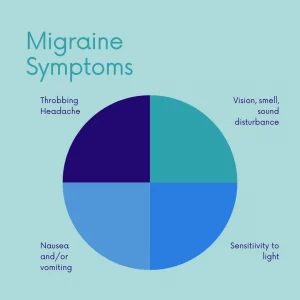What are migraines?
Migraine is a complex condition with a wide variety of symptoms. The main feature is a painful, often throbbing, headache. Other symptoms may include disturbed vision, sensitivity to light, sound and smells, feeling sick and vomiting.¹

However, the symptoms will vary and people can experience different symptoms during different attacks. Attacks can last from 4 to 72 hours and most people are free from symptoms between attacks. Migraine can have an enormous impact on work, family and social lives.
What are the causes of Migraine?
There is no known cause for migraine, although most people with it are genetically predisposed to migraine. If you are susceptible to migraine there are certain triggers which commonly occur. These include stress, lack of food, alcohol, hormonal changes in women, lack of sleep and the environment.
A recent online article in The Guardian (Australia) newspaper stated ‘despite the Global Burden of Disease study finding migraine to be the sixth-highest cause worldwide of years lost due to disability, migraine is an under-recognised condition that is often treated with the wrong drugs.’³
- Migraines typically affect women more frequently than men - in the UK, 1 in 4 women, 1 in 12 men experience migraine
- Most migraine sufferers experience their first migraine in young adulthood, but it is possible for migraines to start later in life
- 5.85 million people aged 16-65 years experience 190 000 migraine attacks every day and lose 25 million days from work or school each year because of them²
The complex nature of migraine means that the treatments available are varied and differ from person to person. There is currently no cure for migraine.
Can Reflexology help Migraines?
In an effort to answer the question above, and to assess effective alternative treatments to medication (many of which have unwanted side effects, as well as being costly to prescribe), the Association of Reflexologists carried out a research project to detail the potential benefits that reflexology may offer to migraine sufferers.
Professionally qualified AoR reflexologists collected data and case study histories for people with migraine, and treated them with regular foot reflexology for 6 or more sessions. The requirements for clients were:
They had a migraine diagnosis by GP or hospital
They were still experiencing migraines
They hoped to benefit from reflexology
Their migraines were of sufficient frequency to see a difference over 6 treatments or more (e.g. one migraine a year would not be frequent enough)
What the Data revealed
Highlights of the published study⁴ showed that:
Self-funded, self-referred case series using MYMOP can indicate change in migraine patients
90% of the participants in this study resulted in a profile change of more than one point in the 7-point MYMOP scale
This change is recognised as being of clinical significance to the individual
60% exhibited a zero MYMOP score for symptom 1 after six treatments
These results indicate that reflexology has the potential to provide relief from symptoms of migraine. Imagine if reflexology were prescribed as part of the management for migraine symptoms? It is my belief that the burden of costs to the NHS over a migraine patient’s lifetime could potentially be significantly reduced if holistic therapies were considered as a front-line first intervention.
Reflexology Helped this Client's Migraine
To show you how the study worked in real life, I want to share one of my client’s experiences (shared with permission).
My client Annie* is female. At the time of the study Annie was in the age group 41- 50 and came to me almost in despair, hoping for some help with her migraines. She’d recently had a very scary incident with a severe hemiplegic migraine, which had resulted in a hospital stay, and then a lasting left-side weakness afterwards.
She was experiencing at least 2 migraines EVERY week. On average they were lasting 3 days. She’d been experiencing migraines for at least 25 years. In order to get by, she needed to take fairly strong medication - which she didn’t like (because of the side effects) and wanted to stop taking.
For collection data, we used a MYMOP recording form. This was used to assess two physical or mental symptoms, and rate them on a scale, where 0 was the best it could be, and 6 was the worst it could be. We also had a score for an activity that the problem made difficult, and one for general wellbeing. These criteria were all scored ‘on the day’ when Annie came for her reflexology.
Treatment Notes
Annie found that almost all the points that I worked on her feet during her first treatment were very sensitive. From my reflexology point of view, this indicated to me that many areas of the body were out of balance.
I worked very gently with each point, particularly those of the head, neck and spine, aiming to soothe the nervous system response. Over time, at each session, Annie was able to tolerate more touch, with a little less sensitivity.
I worked the same specific reflexes for the head, neck and spine each time, incorporated into a full reflexology routine. By the time we got to the 12th session, Annie's feet were normal to touch, were not sensitive to any degree and felt more balanced overall.

The day after her first reflexology session, where Annie was almost unable to tolerate the lightest of touch, I receive this email:
“Wow! I just had to email to let you know I feel absolutely great! I had a slight headache on Monday afternoon (not bad enough to take any tablets) & felt quite sleepy but woke up on Tuesday with no headache, no pressure in my head & just very relaxed about everything. I haven’t felt like that for at least a year. Today I’ve woke up feeling exactly the same. Even my Mum said, it’s like having the old you back!!”
What a great message to receive. We carried on with the reflexology over 2 sets of 6 sessions (a total of 12) for about a year. We continued assessing the symptoms with MYMOP forms, and although not every session had such noticeable results, we did see a massive change overall.

As you can see from the charts above, the symptoms of migraine scored 0 by the 12th session. This client showed an amazing progression from non-tolerance of touch, with twice weekly migraines, to being able to experience reflexology in comfort and ease, with ZERO migraines. Annie was able to work without the fear of regularly needing sick leave for migraines. Her life at home was more enjoyable because her wellbeing was better overall. Her migraines disappeared.
I recently got in contact with Annie, to ask if migraines were still a part of her life or not - she replied that she had experienced only one or two, which she recognised were likely responding to extreme life stresses at the time (moving house, divorce etc.)
This pattern has been repeated for other clients with migraines (admittedly less severely affected than Annie) and the data collection overall showed that having reflexology treatments made a statistical improvement for clients treated in the study.
*Names have been changed
** References:
1. https://www.migrainetrust.org/ The Migraine Trust, online
2. https://pubmed.ncbi.nlm.nih.gov/12950377/ 2003 Sep;23(7):519-27. doi: 10.1046/j.1468-2982.2003.00568.x. The prevalence and disability burden of adult migraine in England and their relationships to age, gender and ethnicity, T J Steiner, A I Scher, W F Stewart, K Kolodner, J Liberman, R B Lipton
3. https://www.theguardian.com/australia-news/2021/jul/01/i-usually-end-up-calling-an-ambulance-why-migraine-pain-is-not-just-a-bad-headache
4. https://www.sciencedirect.com/science/article/abs/pii/S1744388120311051?dgcid=coauthor&fbclid=IwAR28mZABtyQb1zGWRaO7gWtqup59wImVnVS4kfWbMmw1lWJSuUDr5egrRyY, Complementary Therapies in Clinical Practice, Volume 41, November 2020, 101230, A pragmatic case series of clients living with medically diagnosed migraines self-referred to reflexology, Tracey A.Smith, Sarah L.Thurgood²
